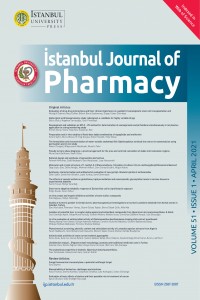Synthesis, characterization and antibacterial evaluation of new pyridyl-thiazole hybrids of sulfonamides
Abstract
Background and Aims: Sulfonamide drugs are a very old and noted group of small molecules, and are still one of the most important antimicrobial compounds. In this study, starting from sulfonamide drugs, new original compounds containing frequent and functional rings such as thiazole and pyridine were synthesized and their antimicrobial effects were evaluated. Methods: Eighteen new compounds were synthesized by converting the 4-amino group of the sulfonamides to thiourea, and continued by thiazole ring closure. Characterization of the compounds was carried out by FT-IR, 1H-NMR and 13C-NMR and HRMS. MIC values were obtained in antimicrobial activity studies, which were carried out by Broth Microdilution method. Results: Compounds 3p-r had an effect of 32 μg/ml against B. spizizenii. In addition, compounds 3d-f and 3p-r each showed effect against different gram-positive bacteria. Compound 3r had an MIC of 128 μg/mL against gram-negative organisms. The rest of the series did not affect gram-negative bacteria. In the study, chloramphenicol and sulfamethoxazole were used as standards. Conclusion: Sulfanilamide and sulfadiazine derivatives showed higher inhibitory effects compared to the rest of the series. 3d-f and 3p-r showed inhibitor activity against gram-positive bacteria, conversely to the standard drug sulfamethoxazole, which possibly means that the mechanism of action is not same.
Keywords
References
- • Başar, E., Tunca, E., Bülbül, M., & Kaya, M. (2016). Synthesis of novel sulfonamides under mild conditions with effective inhibitory activity against the carbonic anhydrase isoforms I and II. Journal of Enzyme Inhibition and Medicinal Chemistry, 31(6), 1356–1361.
- • Bengoechea, J. A., & Pessoa, J. S. (2018). Klebsiella pneumoniae infection biology: living to counteract host defences. FEMS Microbiology Reviews, 43(2), 123-144.
- • Donnenberg, M. S., & Whittam, T. S. (2001). Pathogenesis and evolution of virulence in enteropathogenic and enterohemorrhagic Escherichia coli. Journal of Clinical Investigation, 107(5), 539–548.
- • Drobniewski, F. A. (1993). Bacillus cereus and related species. Clinical Microbiology Reviews, 6(4), 324–338.
- • El-Sayed, A., Solimana, M., El-Zahar, I., El-Masry, A. H., Kamel, M., & Gohar, R. S. (2010). Synthesis and anticancer evaluation of novel tetrahydronaphthalen-6-yl thiazole heterocycles against human HePG2 and MCF7 cell lines. Der Pharma Chemica 2(5), 507-521.
- • Ertas, M., Sahin, Z., Berk, B., Yurttas, L., Biltekin, S. N., & Demirayak, S. (2018). Pyridine-substituted thiazolylphenol derivatives: Synthesis, modeling studies, aromatase inhibition, and antiproliferative activity evaluation. Archiv der Pharmazie, 351(3-4), 1700272.
- • Gellatly, S. L., & Hancock, R. E. W. (2013). Pseudomonas aeruginosa: new insights into pathogenesis and host defenses. Pathogens and Disease, 67(3), 159–173. • Gowda, B. T., Jyothi, K., & D’Souza, J. D. (2002). Infrared and NMR spectra of arylsulphonamides. Zeitschrift für Naturforschung A, 57a, 967-973.
- • Hamada, Y. (2018). Role of Pyridines in Medicinal Chemistry and Design of BACE1 Inhibitors Possessing a Pyridine Scaffold. Pyridine, doi:10.5772/intechopen.74719.
- • Kashyap, S. J., Garg, V. K., Sharma, P. K., Kumar, N., Dudhe, R., & Gupta, J. K. (2011). Thiazoles: having diverse biological activities. Medicinal Chemistry Research, 21(8), 2123-2132.
- • Russo, T. A., & Marr, C. M. (2019). Hypervirulent Klebsiella pneumoniae. Clinical Microbiology Reviews, doi:10.1128/cmr.00001-19.
- • Sun, S., Jia, Q., Zenova, A. Y., Chafeev, M., Zhang, Z., Lin, S., & Oballa, R. M. (2014). The discovery of benzenesulfonamide-based potent and selective inhibitors of voltage-gated sodium channel Na v 1.7. Bioorganic & Medicinal Chemistry Letters, 24(18), 4397–4401.
- • Supuran, C. (2017). Special Issue: Sulfonamides. Molecules, 22(10), 1642. doi:10.3390/molecules22101642.
Details
| Primary Language | English |
|---|---|
| Subjects | Pharmacology and Pharmaceutical Sciences, Health Care Administration |
| Journal Section | Original Article |
| Authors | |
| Publication Date | April 30, 2021 |
| Submission Date | September 30, 2020 |
| Published in Issue | Year 2021 Volume: 51 Issue: 1 |


